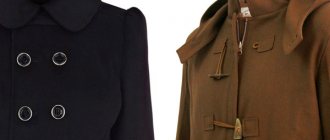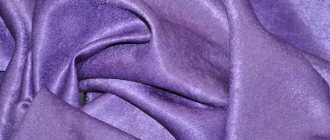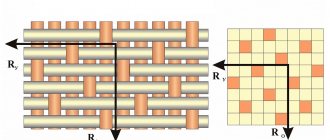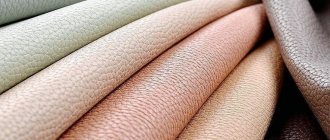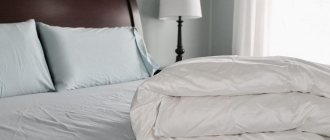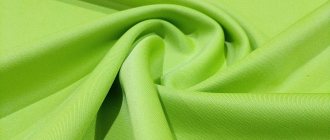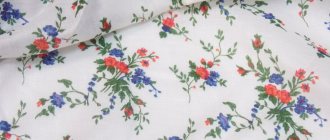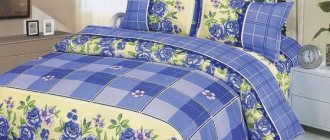What type of fabric is this?
Crepe is a group of fabrics that are similar in the technology of weaving and twisting of threads. A distinctive feature is the rough surface and embossed front side.
Crepe colors
Crepes are produced all over the world. The fibers are twisted, alternating directions: left and right. In this case, the tension is 3000 revolutions per 1 meter of material. The resulting threads are woven using plain weave technology. The material is “cooked” in hot water, due to which some of the threads unwind. The surface is rough and embossed.
When making crepe, two types of weaving are used:
- Crepe twist. With this technology, the threads are twisted diagonally, alternating directions from left to right. In this case, small intervals are allowed. The resulting fabric is processed in hot water. Some of the threads unwind and a relief surface with roughness is obtained.
- Finely patterned weaving. With this technology, the threads are not twisted, but intertwined. In this case, the tension of the threads is not constant, but different. The interweaving of the threads is done chaotically, so the pattern has no pattern.
Description of the crepe jersey fabric
Many people are interested in Barbie fabric: description, characteristics and what this material actually is. The material in question belongs to the category of natural fibers. In terms of external characteristics, knitted crepe is very similar to diving crepe. This similarity is observed in the pronounced crepe texture, and their inner and outer sides are pleasant to the body.
In the photo - crepe fabric:
Crepe fabric
Properties of knitted crepe
Knitted crepe is a material that is quite soft and has a medium density. It is stretchy and can stretch in all directions. The outer side of the material is grainy when palpated. This is the distinctive feature of knitted crepe. Also, its surface has a beautiful matte shine. Knitted fabric can be used in the manufacture of dresses, skirts and other women's paraphernalia.
Products made from the fabric in question do not wrinkle, are highly breathable and have a long service life. The positive properties of the material are due to the fact that high-quality raw materials are used in its manufacture.
Read the description of Otto knitwear.
Reviews of angora knitwear fabric: .
The advantages of the material include:
- density and strength;
- good wear resistance;
- low creasing;
- good drapability.
The process of creating knitted crepe involves the use of repeated twisting of the threads to the right and to the left. In this case, the fibers do not cross constantly. This allows you to give the material additional strength and density. When palpating the material, a characteristic roughness can be detected.
Of course, the pressing question for many girls remains: does knitted crepe stretch or not? The material stretches very difficult, and this is due to the fact that during manufacturing the threads are twisted, as a result of which the material turns out to be inelastic and dense.
Video description of crepe fabric:
But you can preserve the original appearance of a product made from knitted crepe only if you follow these simple recommendations:
- Drying clothes should occur in natural conditions. Do not use artificial heat sources or a drying chamber.
- To strip the product, use special compounds that are suitable for this type of fabric.
- Ironing should be done from the inside and in a slightly damp state.
- Due to the strong twist of the threads, the fabric may shrink when washed in hot water. So use water at room temperature.
- Knitted crepe clothes should be stored in paper bags, and the room should be well ventilated.
- Products with a complex cut should not be washed by hand. In this case, it is better for you to visit a dry cleaner.
Fabric composition and properties
Since crepe combines several types of fabrics, it may contain natural fibers: silk, wool, cotton and viscose, as well as synthetic fibers: acrylic, polyester. A large number of different variations of natural and synthetic threads are acceptable.
Catalog of fabrics made from natural fibers
Crepe properties:
Quite durable and wear-resistant. A product made from it will last a long time.
Dyed crepe does not fade or fade over time.
The material practically does not wrinkle and holds its shape well.
The fabric is very dense, but at the same time quite light.
Crepe can be used to make beautiful folds for drapery without using much effort.
Characteristics: positive and negative
Stretch crepe has a lot of positive indicators.
| Characteristic | Description |
| Can stretch well | Provided with elastane, spandex |
| Elasticity | 2-3% stretch fibers in the composition have a positive effect on service life |
| Wear resistance | Maintains appearance even after long wear |
| Shape retention, resistance to wear | Does not deform, is not prone to stretching or shrinking, despite frequent long-term use |
| Tactility | The material is pleasant to the touch |
| Good heat transfer | The fabric is dense, but allows air to move freely, which gives the body a pleasant coolness |
The only drawback is the ban on machine washing.
Types of fabric
The group of fabrics united under one name “crepe” includes:
Wool crepe
Made from wool with the addition of synthetics. Popular in the manufacture of outerwear.
Crepe satin
Made from natural silk. Sometimes viscose is added to the material. It has a beautiful shine and good air exchange. Sewing from this type of crepe is quite complex. The material is translucent.
Crepe stretch
Made from viscose with the addition of synthetics. The material is quite dense, stretches well and is inexpensive.
Crepe chiffon
Made from natural silk. The material is translucent and difficult to care for. It costs expensive.
Crepe jacquard
Thick fabric with a pronounced pattern. Made from natural materials with the addition of synthetics.
Crepe diving
Sufficiently elastic fabric, environmentally friendly, without the addition of synthetics.
Crepe reaper
Made from natural fibers. A distinctive feature is a bright pattern, quite thin. Popular in the manufacture of home textiles.
Characteristics
Silk, wool, cotton and artificial threads are used in production. Quality depends on the following properties:
- Lightweight and significant density of the material. It can be worn in the warm season. Suitable for sewing sweaters and thin dresses.
- Strength. Thanks to the thread twisting technology, crepe is not only one of the most wear-resistant materials, but also has an original structure and relief.
- Not subject to fading. The brightness of clothes remains for a long time.
- Stretch crepe has good stretch.
Any fabric has its advantages and disadvantages. Crepe has high strength and a long service life . There is always the opportunity to purchase modified products, as the choice is huge. Such clothes will create a representative image. Disadvantages: requires constant care, expensive material . It is negatively affected by exposure to sunlight.
In order for a skirt, suit or dress to serve for a long time and not lose its original advantages, you need to take care of the product:
- use a gentle washing mode, and it is better to do it manually or take the clothes to the dry cleaner;
- iron the item using a thin cloth pad or gauze to avoid damage;
- cannot be dried in a natural environment; it is necessary to protect the crepe product from exposure to the sun.
Pros and cons of fabric
Pros:
- It is quite durable and wear-resistant, so a product made from it will last a long time.
- Lightweight, fits nicely to the body.
- A very wide variety of colors, and the color does not fade or wash out over time.
- It practically does not wrinkle and holds its shape well.
- Looks beautiful due to the bright and varied colors.
- Large selection of fabric according to its composition.
Minuses:
- Crepe made from natural material is quite expensive.
- Difficult to care for.
- There is practically no stretch, with the exception of stretch crepe.
- Absorbs unpleasant odors well.
- May shrink when washed.
Advantages and disadvantages of crepe
The quality of crepe fabrics also directly depends on what threads are at their core. For example:
- Crepe georgette, woven from silk threads, has a pleasant rough surface that feels comfortable in both low and high air temperatures. It hardly wrinkles and drapes easily, allowing you to create any silhouettes and folds. Among the negative qualities is the high price, after washing it can shrink slightly and is difficult to cut, which makes the product more expensive. Crepe georgette made from synthetic threads is less capricious and cheaper.
- Crepe de Chine has excellent breathability, retains color for a long time, practically does not wrinkle and is not afraid of washing.
- Diving crepe fabric is elastic and hygroscopic, which allows you to sew tight-fitting items from it. Clothes made from it are easy to wash, retain their color for a long time, do not wrinkle, and allow air to pass through well. This type of crepe does not like hot water, push-ups or direct sunlight.
- Crepe satin is a beautiful fabric that makes incredibly impressive things, but even a drop of water will leave its mark on it and will have to be rinsed. If worn carelessly, it forms snags, after which the product can be thrown away, but for the sake of the original beauty of the dress, fashionistas go to such troubles.
It is important to know: crepe fabrics will never go out of fashion, since they have much more positive qualities than disadvantages.
When choosing a product from one of its varieties, you just need to carefully study the composition of the material on the label and how to care for it.
How much does the fabric sell for?
The cost of crepe depends on the manufacturer and composition. The more synthetics added to the fabric, the cheaper it will cost. The price per meter starts from 300 rubles and can reach 5,000 rubles.
Crepe is a group of fabrics that are similar in the technology of weaving and twisting of threads. A distinctive feature is the rough surface and embossed front side. Crepes are produced all over the world. It has many advantages and virtually no disadvantages. Depending on the composition, the cost of crepe varies from 300 to 5000 rubles per meter.
Properties
Sometimes it can be difficult to choose an outfit in which you will look perfect and feel comfortable. Stretch crepe is just the material that will fit perfectly on your figure and will not hinder your movements. But besides this, matter has many advantages:
- Durability. The product will last you a long time
- Ability to keep in shape. Even when greatly stretched, matter quickly returns to its original state
- Low crease level
- Drapes beautifully
- Colors well and does not fade
- If the material is made of natural fiber, the body breathes in it
Caring for crepe and its varieties
In order for a crepe item to serve for a long time, you need to know how to properly care for it. This often depends on what is the basis of the material and the technology for its manufacture:
- If the fabric is woven from silk threads, then products made from it must be handled with care. They prefer hand washing with water no higher than 30 degrees. Sometimes a gentle wash at the same temperature is allowed.
- Things made of crepe, which is based on woolen threads, are treated in the same way as clothes made of this fabric of ordinary weaving.
- Any type of crepe should be dried without the use of any heaters or artificial dryers.
- The detergent is selected according to the type of fabric: if it is based on silk, then for it, if it is wool, then with lanolin, etc.
- Most of these types of fabrics do not need ironing, but if it is still required, then it is done only from the inside out and on a slightly dampened fabric.
- Crepe items are stored in cases or bags made of paper or linen in well-ventilated areas.
It is important to know: due to the tight twist of the threads, crepe does not like hot water, because after it it shrinks strongly, so the temperature should not exceed 30 degrees.
In some cases, crepe products require dry cleaning, especially if they have a complex cut.
